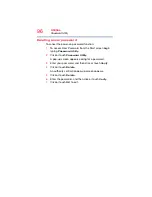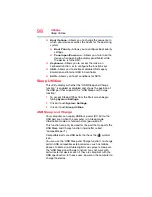
107
If Something Goes Wrong
The Windows
®
operating system is not working
The DC-IN charging indicator light is blinking.
If the DC-IN charging indicator light is blinking, try the
following steps:
1
Connect the AC adaptor to a different power outlet,
preferably in a different room. If the device starts
normally, there may be a problem with the AC outlet
itself, or the voltage level available from it.
2
Verify that the AC adaptor is the correct unit for your
device model. The device may not be able to start from
an AC adaptor that is rated for less current (amperage)
than the device requires, even if the rated voltage is
correct, and the plug fits correctly in the DC-IN socket.
The labels on the bottom of the device and the AC
adaptor show the specifications for voltage (“V”) and
current (“A”) for each device. The voltage level must
match exactly. The amperage rating of the AC adaptor
must be equal to or greater than that required by the
device.
3
The battery may need charging, may be depleted, or
may be defective. With AC power connected, turn the
device on, and then leave the device running for several
hours, which will deliver a slow, steady “trickle-charge”
to the battery. Once the battery has been trickle-
charged, it may begin working correctly again.
If the trickle-charging does not prove effective, you can
connect to Support Online by going to Toshiba support at
.
The Windows
®
operating system is not
working
Once you are familiar with your device and used to the way
the operating system responds to your work routine, you can
easily detect if the operating system is not working correctly.
For example:
❖
The operating system fails to start after the initial startup
appears.
❖
The operating system takes a long time to start.
❖
The operating system responds differently from the
normal routine.
❖
The screen does not look right.






























